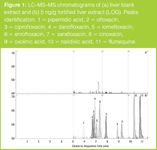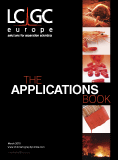Determination of Quinolone Antibiotics in Bovine Liver Using Agilent SampliQ QuEChERS Kits by LC–MS–MS
The Application Notebook
The procedure involves a rapid and efficient pretreatment by SampliQ QuEChERS kits. The homogenized liver sample was initially extracted in a buffered aqueous, 5% formic acid acetonitrile system. An extraction and partitioning step was performed after the addition of salts. Clean-up was done using dispersive solid-phase extraction (dispersive-SPE). The final extracts allowed determination of all compounds in a single run using LC–ESI-MS–MS operating in positive ion multiple reaction monitoring (MRM) mode. Norfloxacin was selected as the internal standard. The accuracy of the method, expressed as recovery, was between 62 and 113%. The precision, expressed as RSD, was between 2.2 and 13.4%. The established limit of quantification (LOQ) was 5 ng/g and is significantly lower than the respective maximum residue limit (MRL) for quinolones in food producing animals.
Limian Zhao and Joan Stevens, Agilent Technologies Inc., Wilmington, Delaware, USA.
The procedure involves a rapid and efficient pretreatment by SampliQ QuEChERS kits. The homogenized liver sample was initially extracted in a buffered aqueous, 5% formic acid acetonitrile system. An extraction and partitioning step was performed after the addition of salts. Clean-up was done using dispersive solid-phase extraction (dispersive-SPE). The final extracts allowed determination of all compounds in a single run using LC–ESI-MS–MS operating in positive ion multiple reaction monitoring (MRM) mode. Norfloxacin was selected as the internal standard. The accuracy of the method, expressed as recovery, was between 62 and 113%. The precision, expressed as RSD, was between 2.2 and 13.4%. The established limit of quantification (LOQ) was 5 ng/g and is significantly lower than the respective maximum residue limit (MRL) for quinolones in food producing animals.
Sample Preparation and HPLC Instrument Conditions
Sample preparation and HPLC conditions available in its entirety in the Agilent publication 5990-5085EN. Figure 1 shows the MRM chromatograms of liver control blank and 5 ng/g fortified liver extract (LOQ). The liver control blank chromatogram indicated that it was free from any interference to the target analytes. The 5 ng/g fortified liver extract chromatogram demonstrated that the 5 ng/g limits of quantification (LOQ) for all of analytes were well established with a signal-to-noise ratio (S/N) greater than 5.

Figure 1
Recovery and Reproducibility
The recovery and reproducibility (shown as RSD) data are shown in Table 1. It can be seen from the results that all of quinolones except pipemidic acid gave excellent recoveries (average of 95.9%) and precision (average of 6.6% RSD). Pipemidic acid gave lower recovery (average of 66.7%) but great precision (average of 5.7% RSD). Additionally, it still meets the 5 ng/g LOQ requirement.

Table 1: Recovery and repeatability of pesticides in fortified liver with 2 mL dispersive-SPE tube (p/n 5982-4921).
Conclusions
The QuEChERS procedures presented here appear to be a promising reference method for the quantitative analysis of quinolones in food products of animal origin. This method also has the potential to extend the applications of SampliQ QuEChERS extraction and dispersive-SPE kits to the quantitative analysis in other bio-matrices, such as animal food products and bio-fluids, rather than just plant matrices. Agilent SampliQ QuEChERS EN Extraction kits, p/n 5982-5650 and SampliQ QuEChERS dispersive-SPE kits for Drug Residues in Meat, 2 mL, p/n 5982-4921.
The complete text of this application first appeared as Agilent Technologies publication 5990-5085EN.

Agilent Technologies Inc.
2850 Centerville Road, Wilmington, Delaware 19808, USA
tel. +1 800 227 9770 fax +1 302 633 8901
Website: www.agilent.com

Regulatory Deadlines and Supply Chain Challenges Take Center Stage in Nitrosamine Discussion
April 10th 2025During an LCGC International peer exchange, Aloka Srinivasan, Mayank Bhanti, and Amber Burch discussed the regulatory deadlines and supply chain challenges that come with nitrosamine analysis.














